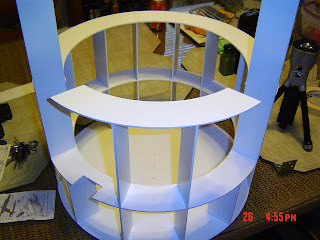Once you bond your blueprint to the Styrene,
You can get ready for the routing.
If you notice, There are 3 small holes in the center of the circle.
These are marked on the blueprint and I used a 1/8 drill bit to mark
the location of each.
The outer 2 holes are for the center leg to mount and the center hole
is your pilot hole for the router pin.
Carefully run the router around the 20x20 inch Styrene plate and you will get your
rough cut using the R9 pin hole.
Then using the 9 pin hole, Run around the plate again and you will get a nice
smooth plate.
Now lightly scribe the lines marked on the blueprint.
These lines will be used as a mark for the vertical plates to be glued.
The solid lines on each side get cut completely off the plate and saved for
a future plate.
Now you can peel the blueprint off the plate and I lightly sand the sides
of the plate, Just to make it nice and clean.













































